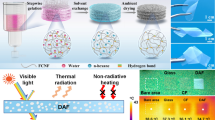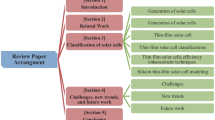Abstract
Direct absorption solar collectors (DASCs), which absorb solar radiation energy by the working medium, attract considerable attention. Because the addition of nanoparticles can improve the efficiency of solar collectors, nanofluids can be used as the working fluid. The stability, optical properties and thermal conductivity of propylene glycol–water based nanofluids containing TiO2, SiC and multiwalled carbon nanotubes (MWCNTs) are investigated in this paper. The results confirmed that nanofluids with surfactant exhibited good stability. By combining comprehensive transmittance, extinction coefficient and the solar-weighted absorption coefficient (Am) measurements, the transmittance of TiO2 and SiC nanofluids decreased from 65% at 0.025 vol% to about 5% at 0.2 vol%, and the light can hardly pass the MWCNT nanofluids over 0.05 vol%. MWCNT nanofluids had the highest Am, followed by SiC nanofluids and TiO2 nanofluids, which exhibited optimum properties even at low concentration. In addition, thermal conductivity of nanofluids increased with the growing volume fractions and temperature. MWCNT nanofluids had the maximum thermal conductivity (0.508 W/m k at 0.2 vol%) at 20 °C. This work provides valuable insights into the optical and thermal property enhancement of nanofluids for increasing the efficiency of DASCs.










Similar content being viewed by others
Abbreviations
- \({\varphi _{\text{v}}}\) :
-
Volume fraction [%]
- m :
-
Mass [g]
- \(\rho\) :
-
Density [g/cm2]
- ζ :
-
Zeta potential [mV]
- K(λ):
-
Extinction coefficient
- T(λ):
-
Spectral transmittance
- L :
-
Optical path [cm]
- Am:
-
Solar-weighted absorption coefficient
- λ :
-
Wavelength [nm]
- \({I_{{\text{b}}\lambda }}\left( \lambda \right)\) :
-
Incident solar intensity [cd]
- h :
-
Planck’s constant [J s]
- k B :
-
Boltzman constant [J/K]
- c 0 :
-
Speed of light in vacuum [m/s]
- k :
-
Thermal conductivity [W/m k]
- T solar :
-
Temperature [°C]
References
N.S. Lewis, D.G. Nocera, Powering the planet: chemical challenges in solar energy utilization. Proc. Natl. Acad. Sci. 103(43), 15729–15735 (2006)
T.P. Otanicar, J.S. Golden, Comparative environmental and economic analysis of conventional and nanofluid solar hot water technologies. Environ. Sci. Technol. 43(15), 6082–6087 (2009)
W. Li, C. Zou, X. Li, Thermo-physical properties of cooling water-based nanofluids containing TiO2, nanoparticles modified by Ag elementary substance for crystallizer cooling system. Powder Technol. 329, 434–444 (2018)
S.M. Ladjevardi, A. Asnaghi, P.S. Izadkhast et al., Applicability of graphite nanofluids in direct solar energy absorption. Sol. Energy 94, 327–334 (2013)
R. Saidur, T.C. Meng, Z. Said et al., Evaluation of the effect of nanofluid-based absorbers on direct solar collector. Int. J. Heat Mass Transf. 55(21), 5899–5907 (2012)
H.K. Gupta, G.D. Agrawal, J. Mathur, Investigations for effect of Al2O3–H2O nanofluid flow rate on the efficiency of direct absorption solar collector. Case Stud. Therm. Eng. 5, 70–78 (2015)
V. Khullar, H. Tyagi, N. Hordy et al., Harvesting solar thermal energy through nanofluid-based volumetric absorption systems. Int. J. Heat Mass Transf. 77, 377–384 (2014)
H. Tyagi, P. Phelan, R. Prasher, Predicted efficiency of a low-temperature nanofluid-based direct absorption solar collector. J. Sol. Energy Eng. 131(4), 041004 (2009)
R.C. Shende, S. Ramaprabhu, Thermo-optical properties of partially unzipped multiwalled carbon nanotubes dispersed nanofluids for direct absorption solar thermal energy systems. Sol. Energy Mater. Sol. Cells 157, 117–125 (2016)
T.P. Otanicar, P.E. Phelan, R.S. Prasher et al., Nanofluid-based direct absorption solar collector. J. Renew. Sustain. Energy 2(3), 033102 (2010)
R.A. Taylor, P.E. Phelan, T.P. Otanicar et al., Nanofluid optical property characterization: towards efficient direct absorption solar collectors. Nanoscale Res. Lett. 6(1), 1–11 (2011)
Z. Said, M.H. Sajid, R. Saidur et al., Evaluating the optical properties of TiO2 nanofluid for a direct absorption solar collector. Numerical Heat Transf. Part A Appl. 67(9), 1010–1027 (2015)
Q. He, S. Wang, S. Zeng et al., Experimental investigation on photothermal properties of nanofluids for direct absorption solar thermal energy systems. Energy Convers. Manag. 73, 150–157 (2013)
T.P. Otanicar, P.E. Phelan, J.S. Golden, Optical properties of liquids for direct absorption solar thermal energy systems. Sol. Energy 83(7), 969–977 (2009)
K.S. Suganthi, V.L. Vinodhan, K.S. Rajan, ZnO–propylene glycol–water nanofluids with improved properties for potential applications in renewable energy and thermal management. Coll. Surf. A 506, 63–73 2016
K.S. Suganthi, K.S. Rajan, A formulation strategy for preparation of ZnO–propylene glycol–water nanofluids with improved transport properties. Int. J. Heat Mass Transf. 71, 653–663 (2014)
M.T. Naik, G.R. Janardhana, K.V.K. Reddy et al., Experimental investigation into rheological property of copper oxide nanoparticles suspended in propylene glycol–water based fluids. ARPN J. Eng. Appl. Sci. 5(6), 29–34 (2010)
S. Manikandan, K.S. Rajan, Sand-propylene glycol–water nanofluids for improved solar energy collection. Energy 113, 917–929 (2016)
K.S. Hong, T.K. Hong, H.S. Yang, Thermal conductivity of Fe nanofluids depending on the cluster size of nanoparticles. Appl. Phys. Lett. 88(3), 031901 (2006)
M. Karami, M.A. Akhavan-Behabadi, M.R. Dehkordi et al., Thermo-optical properties of copper oxide nanofluids for direct absorption of solar radiation. Sol. Energy Mater. Sol. Cells 144, 136–142 (2016)
A. Handbook, Physical properties of secondary coolants (Brines). ASHRAE 21, 21.6–21.7 (2005)
S. Witharana, I. Palabiyik, Z. Musina et al., Stability of glycol nanofluids—the theory and experiment. Powder Technol. 239, 72–77 (2013)
W. Evans, R. Prasher, J. Fish et al., Effect of aggregation and interfacial thermal resistance on thermal conductivity of nanocomposites and colloidal nanofluids. Int. J. Heat Mass Transf. 51(5), 1431–1438 (2008)
S.K. Sharma, S.M. Gupta, Preparation and evaluation of stable nanofluids for heat transfer application: a review. Exp. Thermal Fluid Sci. 79, 202–212 (2016)
A. Ghadimi, R. Saidur, H.S.C. Metselaar, A review of nanofluid stability properties and characterization in stationary conditions. Int. J. Heat Mass Transf. 54(17), 4051–4068 (2011)
Y.J. Hwang, Y.C. Ahn, H.S. Shin et al., Investigation on characteristics of thermal conductivity enhancement of nanofluids. Curr. Appl. Phys. 6(6), 1068–1071 (2006)
D.H. Yoo, K.S. Hong, H.S. Yang, Study of thermal conductivity of nanofluids for the application of heat transfer fluids. Thermochim. Acta 455(1), 66–69 (2007)
H.E. Patel, T. Sundararajan, S.K. Das, An experimental investigation into the thermal conductivity enhancement in oxide and metallic nanofluids. J. Nanopart. Res. 12(3), 1015–1031 (2010)
J.C. Maxwell, On Electricity and Magnetism. (Oxford University Press, Oxford, 1881)
R.L. Hamilton, O.K. Crosser, Thermal conductivity of heterogeneous two component systems. I&EC Fund 1(3), 187 (1962)
Y. Xuan, Q. Li, W. Hu, Aggregation structure and thermal conductivity of nanofluids. Aiche J. 49(4), 1038–1043 (2003)
Acknowledgements
This work was financially supported by the National Natural Science Foundation of China, China National Petroleum Corporation Petrochemical Unite Funded Project (U1662106).
Author information
Authors and Affiliations
Corresponding author
Rights and permissions
About this article
Cite this article
Tan, N., Zhang, Y., Wei, B. et al. Experimental investigation on optical and thermal properties of propylene glycol–water based nanofluids for direct absorption solar collectors. Appl. Phys. A 124, 569 (2018). https://doi.org/10.1007/s00339-018-1994-6
Received:
Accepted:
Published:
DOI: https://doi.org/10.1007/s00339-018-1994-6




